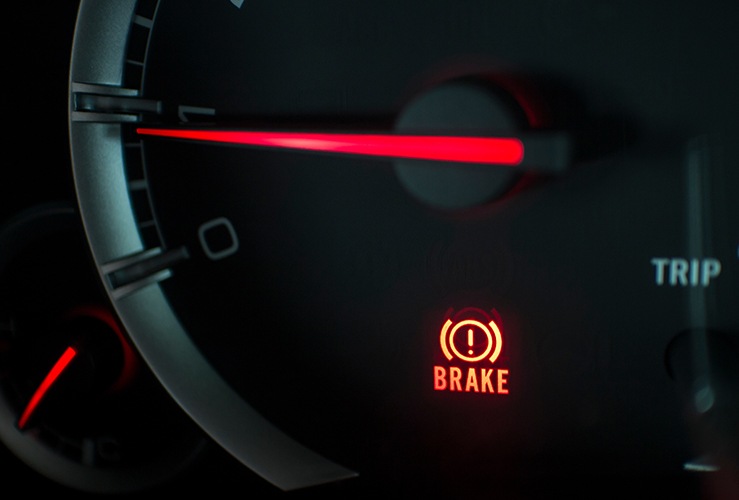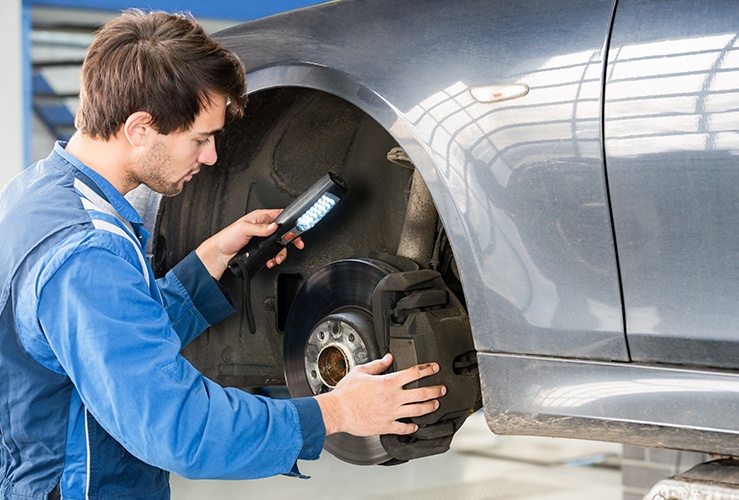Learn how to keep this critical safety feature in good working order.
Your vehicle's brakes are critical for keeping you and your passengers safe on the road. If they aren't working properly, you won't be able to safely carry out stop-start driving, or effect an emergency stop quickly enough.
But how often should you check your brakes for wear and tear? And what are the tell-tale signs your brakes could be worn?
We've put together the following guide to help you determine when your brakes need replacing.
How often should I check my brakes?
It's sensible to check your brakes every six months or so. While a set of brake pads can last anywhere between 30,000 and 70,000 miles (the UK annual average mileage is under 8,000), you should still check this vital safety system on an ongoing basis.
The signs listed below mean you should have your brakes checked by a professional.
Check brake pad wear/identify brake faults: common signs
Squealing or grinding noises: This indicates that your brake pads have worn down to the point that the metal is making contact with the brake discs. If your vehicle has rotors, and they are grinding against the metal beneath the brake pad material, they may need to be replaced. Many modern cars have wear indicators that cause a screeching noise when a pad has become worn (more on this below).
Brake warning light: If you see your brake warning light appear (flashing or static) in red or amber, you may have an issue with your braking system, including a brake fluid leak. If it appears and stays on once you start your car, you may have low brake fluid. The brake warning light is not the same as the ABS warning light, but may be the same as the parking brake light.
Car pulling to one side: This suggests one of your brake pads is worn, or there is some other issue with your braking system - including brake fluid leaks, or brake caliper damage.
Burning smell: This may indicate that your brakes are overheated, worn out, or that your calipers are stuck in the wrong position. A burning smell may be more likely with cheaper, lower quality brake pads.
Longer stopping distances: As brake pads wear out, stopping distances may increase. However, it's not always easy to spot this issue, since the wear takes place so gradually. An experienced mechanic will be able to identify a worn brake pad.
Pulsating or vibrating brake pedal: This suggests your rotors are uneven and need to be replaced promptly. Otherwise, it might suggest you have unevenly worn brake pads, damaged or faulty brake calipers or wheel bearings. Less commonly, it can indicate suspension or steering system issues. A pulsating or vibrating brake pedal should not be ignored, since it may mean your vehicle is unsafe to drive.
How to check wear on brake pads: Visual check
With many modern vehicles, it's possible to carry out a quick visual check of the brake pads - if they can be seen through the wheel spokes. A brake pad should have at least 3mm of visible pad.
If you cannot see the brake pads through the wheel spokes, or you do not feel confident carrying out the check yourself, visit a trusted mechanic, who will be able to pinpoint any issues.
A mechanic should remove the wheel to carry out this kind of visual inspection properly. However, some garages do this check without removing the wheels.
How to check brake pads on older cars
Checking the brake pads on older, or classic, cars may be more challenging than on a modern car. Depending on the model, you may need to jack up the car, or remove a wheel in order to check for brake pad wear. Unless you have considerable mechanical experience, it may be easier and safer to enlist a trained mechanic to do the inspection.
In respect of how to check disc brake pads on classic cars, considerably more effort may be needed to ensure your vehicle remains roadworthy. Also note that while a car aged 40+ years can obtain exemption from the MOT, it is wise to have one anyway - so that any issues are identified promptly.
How to check brakes with the wear indicator
Some brake pads have a physical wear indicator. This may be in the form of a wire component that, once the pad has worn down sufficiently, will make contact with the brake disc, creating a screeching sound.
How to check brakes on a used car
Thinking about buying a second hand car? It’s important to check that the brakes are working well. Ask for a test drive, and look out for any of the signs listed above. In addition, you may be able to visually inspect the brake pads through the wheel spokes. You may need a torch to do this, depending on the model and/or lighting conditions.
How long should my brakes last?
Many factors influence how long your brake pads will last.
Those who undertake regular motorway trips will use their brakes less than people who do a lot of stop-start urban driving, and so may find their braking components last considerably longer.
Weight can also play a role. If your vehicle is often loaded with passengers and/or cargo, your brakes will be placed under extra pressure, and so will wear out more quickly.
The way you drive can impact brake wear and tear, too. Sudden, heavy braking will reduce brake pad lifespan sooner than lighter, gentler braking. It follows that keeping your speed down should reduce the need for hard braking.
Road conditions also play a role: if you often have to drive off-road or deal with potholed surfaces, your braking system will require maintenance or repairs sooner.
Brake pad type is another factor: ceramic pads last longest, followed by metallic and semi-metallic pads, then organic pads.
Brake pad quality may also determine how soon you need replacements. Cheaper pads are likely to have a shorter lifespan.






